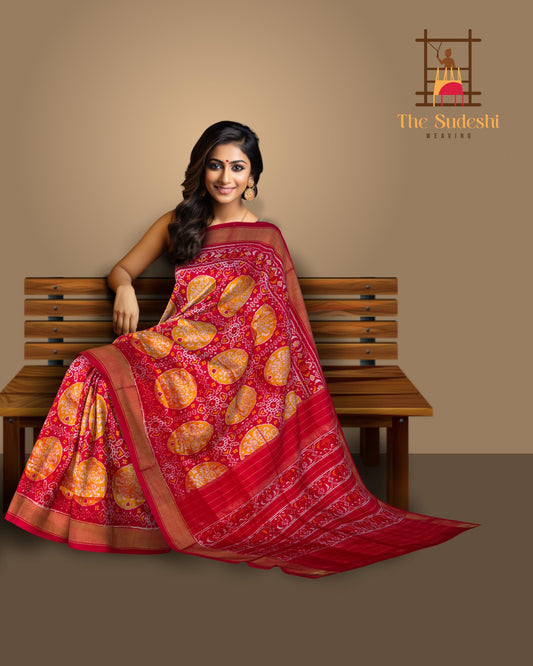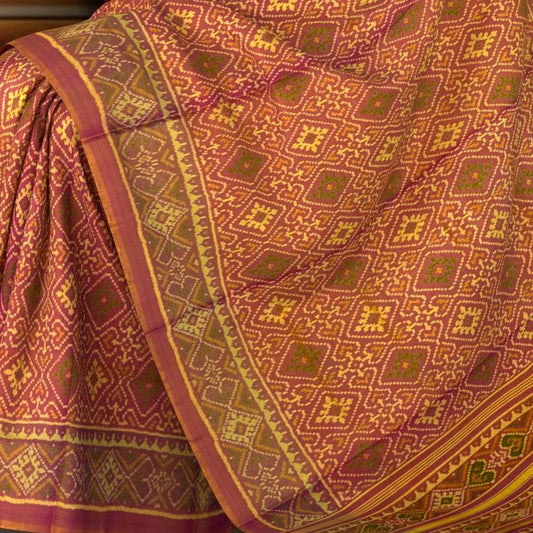Kanchipuram silk Saree vs. Pochampalli: A Comprehensive Comparison of Two Iconic Weaving Styles
The world of traditional Indian textiles is rich and varied, showcasing an array of weaving techniques, patterns, and fabrics. Among these, Kanchipuram Silk Sarees and Pochampalli Ikat stand out as two iconic styles, each with its own unique charm and heritage. This comprehensive comparison will delve into the histories, techniques, and distinguishing features of Kanchipuram Silk saree and Pochampalli, helping you appreciate the craftsmanship behind these beautiful fabrics.
Historical Background
Kanchipuram Silk Sarees
Originating from the town of Kanchipuram in Tamil Nadu, Kanchipuram Silk Sarees have a history that dates back over 400 years. These sarees are renowned for their exquisite silk and intricate zari work, which often features motifs inspired by temples, flowers, and traditional tales. The craftsmanship involved in creating KSS has been passed down through generations, making it an integral part of Tamil Nadu’s cultural heritage.
Pochampalli Ikat
Pochampalli Ikat, hailing from the town of Bhoodan Pochampally in Telangana, is famous for its distinctive geometric patterns and vibrant colors. The weaving technique, known as ikat, involves tie-dyeing the yarn before weaving, which requires immense precision and skill. Pochampalli Ikat has been practiced for centuries and holds a significant place in Indian textile art, often associated with the elegance and vibrancy of Telangana's cultural identity.
Weaving Techniques
Kanchipuram Silk Sarees
The making of a Kanchipuram saree is a meticulous process that involves several stages:
- Silk Preparation: High-quality mulberry silk threads are chosen for their durability and sheen.
- Dyeing: The silk threads are dyed in vibrant hues, ensuring the colors are long-lasting.
- Weaving: Master weavers use traditional handlooms to interlace silk threads with pure gold or silver zari, creating intricate patterns and borders. The pallu (the decorative end piece) and the body of the saree are often woven separately and then joined together with a technique called ‘korvai’.
Pochampalli Ikat
The ikat technique is unique due to its dyeing process:
- Yarn Preparation: Both silk and cotton yarns can be used for Pochampalli Ikat.
- Tie-Dyeing: The yarns are carefully tied and dyed multiple times to achieve the desired pattern. The tying process involves covering sections of the yarn with a tight wrapping to prevent them from absorbing dye, creating intricate designs.
- Weaving: The dyed yarns are then woven on handlooms. Unlike other weaving techniques, the patterns are pre-determined on the yarn itself, requiring precise alignment during the weaving process to ensure the patterns emerge correctly on the fabric.
Distinguishing Features
Kanchipuram Silk Sarees
-
Material: Pure mulberry silk with gold or silver zari.
-
Designs: Temple borders, checks, stripes, and floral motifs.
-
Weight: Heavier due to the rich silk and zari.
-
Durability: Highly durable, often passed down as heirlooms.
-
Occasions: Popular choice for weddings and festivals due to their grandeur.
Pochampalli Ikat
-
Material: Can be made from silk or cotton.
-
Designs: Geometric patterns, traditional motifs, and vibrant colors.
-
Weight: Generally lighter, making them more comfortable for daily wear.
-
Durability: Durable, though the intensity of the colors can vary based on the dyeing process.
-
Occasions: Suitable for both casual and formal occasions, appreciated for their versatility.
Cultural Significance
Both Kanchipuram Silk Sarees and Pochampalli Ikat hold immense cultural value in India.
Kanchipuram Silk Sarees are often seen as a symbol of South Indian tradition and are worn by brides during weddings. The elaborate designs and luxurious feel of these sarees make them a treasured possession in many households.
Pochampalli Ikat, on the other hand, represents the rich weaving heritage of Telangana. The intricate patterns and vibrant colors of Pochampalli sarees make them a popular choice for various cultural and religious events across India.
Market Trends and Popularity
In recent years, both Kanchipuram Silk Saree and Pochampalli have seen a resurgence in popularity, thanks to increased global awareness of traditional Indian textiles. Designers are incorporating these fabrics into contemporary fashion, making them accessible to a broader audience.
Kanchipuram Silk Sarees are often showcased in fashion shows and are a favorite among celebrities for red-carpet events. Their timeless appeal ensures they remain a staple in bridal collections.
Pochampalli Ikat has gained international recognition for its unique patterns and sustainable weaving practices. The versatility of ikat fabric has made it a popular choice for various garments, from sarees to modern dresses and home décor items.
Sustainability and Ethical Practices
Both Kanchipuram and Pochampalli weaving communities have made strides in promoting sustainable and ethical practices. Efforts are being made to ensure fair wages for weavers, use natural dyes, and adopt eco-friendly weaving techniques. These initiatives not only help preserve traditional crafts but also support the livelihoods of artisans.
Conclusion
Kanchipuram Silk Sarees and Pochampalli Ikat are not just fabrics; they are a testament to India’s rich cultural tapestry and the incredible skill of its artisans. While KSS is celebrated for its opulent silk and zari work, Pochampalli Ikat stands out for its vibrant colors and geometric patterns. Both weaving styles offer something unique and timeless, making them cherished pieces in any wardrobe.
Whether you are drawn to the regal elegance of a Kanchipuram saree or the intricate artistry of Pochampalli Ikat, investing in these traditional textiles means embracing a piece of India’s heritage and supporting the artisans who keep these ancient crafts alive.







Leave a comment
Please note, comments need to be approved before they are published.